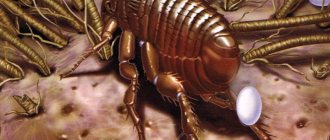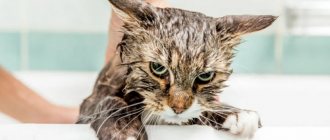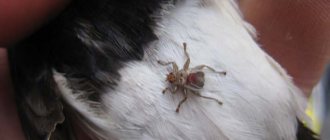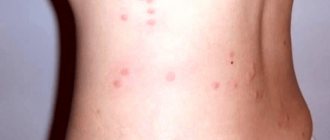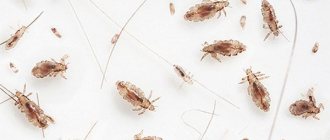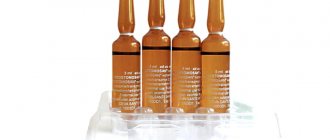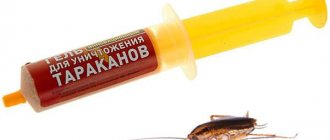Fleas are blood-sucking parasites that are quite common even in domestic cats. Infection with these insects causes anxiety, irritability, and unbearable itching in the animal, which causes scratching to appear on the body. If the owner does not take measures to remove them, the cat may develop serious diseases. In addition, although these parasites do not usually live on humans, their presence in the house can cause a lot of trouble for household members. Some human diseases are transmitted through these blood-sucking creatures.
Fleas in cats: morphology and development cycle
The cat flea is one of the parasites of animals that can also attack humans. She looks like a tiny dark insect without wings. Body size: 0.5–5 millimeters. However, a female engorged with blood can swell up to 16 millimeters.
Fleas parasitize cats and rats. When attacking a person, it selects the area of the legs below the knee.
The lifespan of a flea depends on living conditions and usually ranges from 3 months to 1.5 years.
Favorable conditions for fleas
| Temperature | 20–25 ºС |
| Air humidity | 60 % |
| Humidity | 70 % |
Fleas breed all year round. One female is capable of laying from 2 to 15 eggs at a time. Thus, an individual can reproduce about 500 throughout its life.
Important! This number is arbitrary, since for the eggs to fully mature, the female needs to fully feed on blood.
Places for laying can be different: cracks in the floor or walls, bedspreads or animal beds, food waste, soil, pet hair.
Stages of flea development:
- Egg. A tiny white dot. Size: 0.5 millimeters. Cycle: from 2 days to 2 weeks.
- Larva. Resembles a worm with segmented hairs. Size: about 5 millimeters. It is mobile, growing by eating feces, blood or plant waste. Cycle: from 9 days to 8 months.
- Doll. Looks like a larva in a cocoon. Cycle: from 6 days to 1 year.
- Imago. Is a full-fledged adult.
How do fleas appear on a cat?
The appearance of fleas in cats can be caused by a number of reasons:
- The animal loves to explore the entrances and basements of the house. After all, rooms without ventilation with the same level of humidity and a minimum of light are ideal conditions for the reproduction of fleas.
- Penetration of insects from neighboring apartments. Fleas can move through the thinnest cracks, so there is only one way to protect yourself from uninvited guests after getting rid of them - to make high-quality repairs.
- Contact with an infected cat – even minimal animal contact is enough.
- Carrying fleas on clothes. Unfortunately, the owner can infect the animal on his own, and in this case it is impossible to protect himself from undesirable consequences.
- Inadequate cleaning after treatment of the cat. Simply washing the floors and bowls is not enough: eggs or larvae may remain in furniture, carpets or the animal's bed. If fleas appear in the house again, repeated treatment and better cleaning of the premises is required.
Prevention
- in case of frequent trips to the country or out of town, stock up on anti-flea spray or special drops on the withers;
- protect the cat from contact with stray and any random animals;
- Vacuum and wet clean the room where your pet lives every day;
- Wash or steam animal beds, houses, and toys often enough;
- be attentive to the cat’s behavior, and at the slightest suspicion of the presence of fleas, conduct an examination;
- If parasites are detected, do not postpone measures to combat them;
- undergo periodic examination by a veterinarian.
1111
How dangerous are fleas on a cat?
In cats, fleas can cause both minor health problems and very serious problems. In the first case, the animal is bothered by itching, so it begins to actively scratch: wounds and abrasions appear.
If the owner rids the cat of fleas immediately, there will not be much damage to health. However, in advanced cases, dermatitis may develop. In addition, cats tend to bite and swallow fleas, which is dangerous due to intoxication, helminth infection and even anemia.
Flea allergic dermatitis
Dermatitis in cats is provoked by flea bites and subsequent active scratching. Animals that are prone to allergies are at risk.
Flea saliva consists of complex compounds that are not dangerous in small doses. But if a cat is repeatedly bitten, it may develop hypersensitivity.
Signs of flea dermatitis:
- itching;
- redness;
- scratches, open wounds;
- hair loss.
The disease progresses quickly, so it is important to start treatment as soon as possible. You can also deal with fleas at home. The main thing is an integrated approach.
Important! Flea dermatitis is dangerous due to complications that will inevitably arise in the presence of open wounds. After all, they are a natural environment for bacteria. If an unpleasant odor begins to emanate from the animal, this is a sure sign that the wound has a yeast or bacterial infection.
Anemia in kittens
Anemia is a pathology in which there is a simultaneous drop in the level of red blood cells and hemoglobin in the blood. It can develop in an adult animal. However, it is most dangerous for a kitten’s fragile body due to the likelihood of death.
Anemia can be caused by various reasons. One of them is flea infestation.
Signs of anemia in a kitten:
- weakness;
- pallor/cyanotic/yellowishness of the mucous membrane;
- refusal to eat;
- weight loss;
- dyspnea.
Anemia is a serious disease. It cannot be cured by simply getting rid of the original source, which is cat fleas. Therapy includes taking various medications that are aimed at restoring normal blood composition. And only a veterinarian can prescribe them.
Infectious and parasitic danger of fleas: hemobartonellosis and dipilidia
Hemobartonellosis is an infectious anemia. It is provoked by microorganisms carried by fleas and mosquitoes. Unlike classical anemia, a malfunction of the body occurs due to the fact that microbes directly destroy red blood cells.
The disease is dangerous because it occurs secretly. Symptoms may not appear for up to 5 months after infection.
Signs of hemobartonellosis:
- decreased activity;
- loss of appetite;
- weight loss;
- pallor of the mucous membrane;
- heat;
- enlarged spleen.
Important! Hemobartonellosis requires complex treatment, which may include blood transfusions. And even if the cat recovers, liver or kidney failure may persist.
Dipilidiosis is a disease caused by the cucumber tapeworm. The parasite is white-gray or pink in color. It can reach 70 cm in length and 3 mm in width. A cat can become infected with dipilidia by eating adult fleas - they are the carriers of the pathogen larvae.
Signs of infection:
- weight loss;
- changes in eating behavior;
- The cat is constantly nervous.
Important! Dipylidiasis is also dangerous for humans.
Symptoms of flea infestation
It is difficult to detect fleas at the initial stage. However, this is quite possible if you examine the cat’s stomach. It is in this area that, upon careful examination, insects or their feces can be seen.
Signs of flea infestation:
- active scratching;
- the cat is worried, reacts sharply to stimuli, meows;
- loss of appetite;
- weakness, reluctance to play.
If you do not get rid of fleas on a cat in time, the animal will begin to lose weight, and ulcers will begin to form at the bite sites. In addition, advanced infestation is associated with the presence of bald spots in the fur.
Emergency help for bites
The site of any insect bite should be washed well with running water and soap. When scratching, there is a high probability of introducing an infection from a neighboring area of skin.
Any alcohol-containing tinctures or antiseptics are suitable for treatment. You need to lubricate not only the wound, but also the area around it. Applying cold can help reduce itching and burning.
If there are signs of allergy development - severe swelling, sore throat, lacrimation - take an antihistamine.
For severe itching - Golden Star balm, plantain tincture, Fenistil, any remedy available in the home medicine cabinet.
Diagnostics: how to determine that a cat has fleas?
Before you start fighting fleas, you need to make sure that it is they that are bothering your cat:
- It is necessary to pay attention to where exactly the cat is itching. Fleas are active on the sides and back (or on the whole body if the infestation is advanced), and ticks are active behind the ears and in the groin.
- Flea eggs and feces in a cat. If white and black dots are observed on the skin and at the base of the hair, it means that there are adult fleas on the animal.
- Skin irritation. Ulcers, scratches, and redness are typical signs of an advanced flea infestation.
- Detection of fleas by visual inspection. It’s easy to understand that it’s a flea in front of you. It has a rounded body 0.5 millimeters long and very thin long legs. You can find insects if you simply move the fur in different directions. In addition, fleas will begin to jump off the cat while bathing - no other insect can do this.
Wet paper test
If the cat has a dark color or very thick fur, then visual diagnosis of the presence of ectoparasites will be difficult. There is a simple and proven method with wet paper. With its help, you can check the fur quickly and without stress for the animal.
To do this, you will need to spread sheets of white paper on the floor (you can use pieces of old wallpaper) and place a cat in the center. Next, caress the pet, pet it, comb it, fluff the fur a little to shake out any debris and dust particles. Particular attention should be paid to cleaning the fur in the area of the belly, tail and muzzle.
Then you need to carefully examine the surface of the paper. If black dots are found, they are sprayed with water from a spray bottle.
If the result is positive, black dots on damp paper will be blurred by a dark burgundy (brown) halo. This is flea feces. Since insects feed on blood, it is present in their excrement and, under the influence of water, colors the white sheet. The more dark stains there are, the more fleas there are.
What to do if your cat has fleas: treatment methods and review of remedies
You can remove fleas from a cat using different means. They come in different forms:
- drops;
- shampoos;
- sprays;
- collars;
- pills.
In addition to common sprays, shampoos, and tablets, there are even ultrasonic repellers that hang as a keychain on an animal’s collar. However, not all of them are effective.
Most flea remedies have a prolonged action, that is, the effect lasts for a long time (1-6 months).
Before you start removing fleas, it is important to consider a number of points:
- age of the cat;
- whether the pet is sick (a weakened animal cannot be treated with chemicals);
- tendency to allergies to the components of the drug.
For kittens, pregnant and lactating cats, you will need to buy specialized products.
Fleas on a cat - drops
As a rule, drops require a single use. Depending on their composition, they have a destructive or repellent effect. Products containing insecticides are the most effective, but they must be used strictly according to the instructions (the dosage is calculated based on the weight of the cat). Drops with essential oils are not so toxic, so they are suitable for weakened animals, but in case of advanced infestation they will not be able to help.
List of effective drops:
- Advantage.
- Leopard.
- Advocate.
- Frontline Combo.
- Stronghold.
The advantages of drops include speed (fleas die in 1–2 days), as well as versatility (many drugs simultaneously fight lice, lice and ticks). Disadvantages - the need to prevent the cat from coming into contact with water and small children. In addition, many drops are not suitable for newborn kittens or pregnant or lactating cats.
Important! As a rule, the drops are valid for 3 months. After this period, the animal will need to be processed again.
Fleas on a cat - shampoos
Shampoos kill fleas if you wash your cat once, but do not have a delayed effect. Like drops, depending on the composition, they either repel fleas or destroy them.
List of effective shampoos:
- Outpost.
- Beaphar.
- Mr. Bruno.
- Mr. Kiss.
- Rolf Club.
The advantage of shampoos is that they can be used not only for their intended purpose, but also to wash rugs from beds or wash toys. They are suitable for kittens and pregnant and lactating cats, as long as they do not contain insecticides.
Disadvantages of shampoos: the fragility of the effect and the risk of poisoning the animal if the product is not thoroughly washed off the fur.
Sprays
Using a spray you can remove not only fleas, but also their larvae and eggs. In addition, products of this kind are effective against lice, ticks and lice-eaters.
When choosing a drug, it is worth considering that they come in 2 types:
- for processing animals;
- for processing the room.
List of effective sprays:
- Leopard.
- Celandine.
- Frontline.
- Hartz.
- FitoDoc AB3.
Sprays can kill fleas in a single application, even with an advanced infestation. However, this effectiveness is explained by strong toxicity - if used incorrectly, they can harm the animal and provoke allergies. Although there are drugs that are suitable for 2-day-old kittens, for example Frontline.
Important! Sprays are used strictly according to the instructions. It is not enough to simply treat the animal in a ventilated area. You need to put on your work clothes and then wash them thoroughly. You should also make sure that the drug does not get into your pet’s eyes.
Collars
Collars are also used to kill fleas or repel them. In the first case, the tape is impregnated with insecticides, in the second - with vegetable and essential oils. These points should be taken into account if the animal is still small or is bearing offspring.
Adult cats and kittens over 3 months of age can wear insecticide collars. For kittens, pregnant and lactating cats - with esters.
List of effective tapes:
- Leopard.
- Doctor Zoo.
- Celandine.
- Beaphar.
- Hartz.
Collars last a long time - up to 6 months. There are also models with complex action: against fleas, lice, ticks and lice at the same time. They are not as toxic as sprays, but are not able to cope with insects if the infestation has reached a critical stage. In this case, it is better to apply drops or spray, and then apply tape to the already treated cat.
The key to the effectiveness of the collar is proper wearing. The tape should not fit tightly. A finger should fit freely between the collar and the animal's neck. It is also important to cut off any excess tape that remains after the fastener is attached. The cat may bite it, which will cause poisoning.
Interesting! Manufacturers have long moved away from the monotonous production of black collars. Nowadays you can find ribbons in a variety of colors on the shelves. Now, in addition to protection against fleas, there is also an aesthetic point: you can choose a collar that matches the color of a particular cat.
Pills
Tablets stand apart among flea control products. This is a last resort when the animal is in a neglected state. External preparations are not suitable if the cat has dermatitis and other skin lesions. It is in such cases that it is necessary to resort to tablets.
However, treatment at home cannot be done without consulting a specialist. It should be understood that an animal with a serious infestation requires the help of a veterinarian. The list of drugs in tablet form is quite wide.
There are products for one-time use, and there are those that are taken in a course. There are drugs only against fleas, and there are drugs against fleas and ticks at the same time. Therefore, only a veterinarian can choose the right remedy after examining the animal.
List of known tablets:
- Comfortis.
- Bravekta.
- NexGard.
Important! Manufacturers produce dog flea tablets. They should not be given to cats, even if we are talking about drugs for small breed dogs. Many medications that are intended for canines depress the cat's nervous system.
Home disinfection
After treating a cat, an important step in the fight against fleas is treating the home.
Professional disinfection
Professional disinfection is the most effective. A team of specialists will arrive at your home, assess the sanitary condition of the home and choose the most appropriate disinfection method. Typically, disinfection is carried out either using a heat gun or using chemicals. The owner is only required to prepare the house and pay for the services.
Important! A few days after professional treatment, you may find fleas on the floor. However, do not think that the service was provided poorly. Insects could easily remain in the cracks and gaps, but upon contact with the treated surface they quickly die. A similar phenomenon can be observed within 5 weeks after the visit of specialists.
Disinfect yourself
You can disinfect your home yourself using a spray or powder.
Processing stages:
- Remove children, animals and indoor plants from the house.
- To throw out the trash.
- Move furniture away from the walls. Remove from the walls all objects that hang on them.
- Put on work clothes.
- Spray the entire home, including carpets, upholstered furniture, clothing, shoes and bedding. Particular attention should be paid to the animal's belongings.
- Close doors and windows. Leave the house for several hours, ideally all night.
- Upon return, ventilate the rooms well, wash all surfaces and wash all items that have been processed.
Unlike sprays, powders are less effective, but when using them you do not need to leave your home. It is enough to scatter the granules in places where fleas are most concentrated (cracks, areas behind the baseboard). Upon contact with the granular substance, not only adult individuals die, but also their larvae and eggs.
How to remove fleas from a cat at home using folk remedies: myths and reality
Myth #1: Wormwood repels fleas. This is certainly true. You can pick up several armfuls and place them in different corners of the house. There will be fewer fleas, but the effect will only last until the plant dries out. In addition, the smell of wormwood is specific even to humans. So there is a risk of not only fleas leaving the house, but also guests and household members.
Myth No. 2: Essential oils will save you from fleas. Peppermint, pine, eucalyptus and lavender are safe for cats. As a rule, you can find advice on the Internet that says that you need to dilute a few drops in a glass of water and treat the animal with the resulting solution. Next, the oil concentrate is dripped onto sponges or napkins, which are laid out in different places in the house. However, it is worth considering here that essential oils do not kill insects, but only repel them. So there can be no talk of complete deliverance. In addition, odors disappear quickly: the animal will need to be treated daily, as will the napkins.
Myth #3: Let there be salt and soda. The saline or soda solution is safe for kittens and pregnant and lactating cats. It is prepared like this: 100 grams of the substance are diluted in 1 liter of warm water. It is used according to the following scheme: the animal must be kept in the resulting solution for 10–15 minutes, after which it is washed with baby soap, dried and combed. You can also wash the floors in your apartment with this solution and wash your pet’s bed. However, there are controversial points here too. You can’t keep the whole animal in the solution: the head will still be above the water, which means insects may well run across it. Washing a room with salt is associated with stains, so washing and re-washing is still necessary afterwards. And such solutions are effective only for 3-4 days, and then require repeated use.
Which method of fighting fleas deserves attention is determined by everyone for themselves. However, it is worth understanding that traditional methods either simply repel insects or act for an extremely short time. Therefore, you can resort to them only if the animal is allergic and categorically cannot tolerate the effects of chemicals. However, after this, it is advisable to temporarily transfer the pet to friends and disinfect the home with chemicals.
Actions after detecting and eliminating parasites
After identifying fleas, treating a pet and disinfesting the home, owners need to take care of preventing secondary infestation with parasites. To this end, you should minimize your pet’s contact with stray and street animals, keep the house clean, carefully handle cat accessories (combs, bedding, toilet), and purchase a special flea collar. If you follow these simple rules, the problem of blood-sucking parasites can be solved forever, and your pet will continue to delight its owners with good health and good mood.
Article on the topic: How to remove fleas from a cat?
If you find an error or inaccuracy, please select a piece of text and press Ctrl+Enter.

